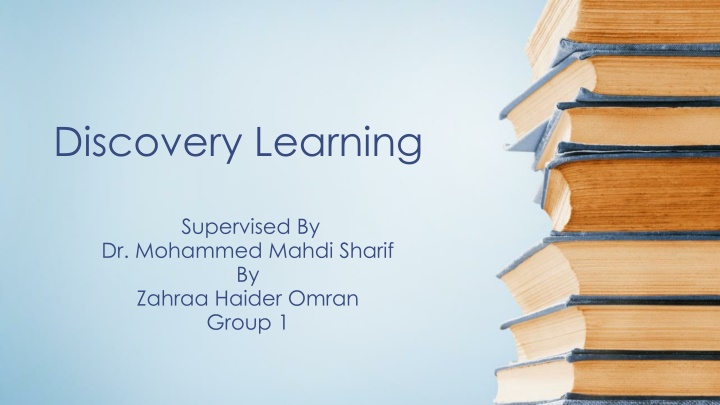
Discovery Learning: Principles, Techniques, and Advantages
Discover the concept of Discovery Learning introduced by Jerome Bruner, its 5 principles, model techniques, advantages, and drawbacks. Explore how this method promotes active learning, problem-solving, and autonomy in education.
Download Presentation

Please find below an Image/Link to download the presentation.
The content on the website is provided AS IS for your information and personal use only. It may not be sold, licensed, or shared on other websites without obtaining consent from the author. If you encounter any issues during the download, it is possible that the publisher has removed the file from their server.
You are allowed to download the files provided on this website for personal or commercial use, subject to the condition that they are used lawfully. All files are the property of their respective owners.
The content on the website is provided AS IS for your information and personal use only. It may not be sold, licensed, or shared on other websites without obtaining consent from the author.
E N D
Presentation Transcript
Discovery Learning Supervised By Dr. Mohammed Mahdi Sharif By Zahraa Haider Omran Group 1
What is Discovery Learning Discovery Learning was introduced by Jerome Bruner, and is a method of Inquiry-Based Instruction. This popular theory encourages learners to build on past experiences and knowledge, use their intuition, imagination and creativity, and search for new information to discover facts, correlations and new truths. Learning does not equal absorbing what was said or read, but actively seeking for answers and solutions.
The 5 Principles of Discovery Learning Model The Discovery Learning Model integrates the following 5 principles: Principle 1: Problem Solving. Principle 2: Learner Management. Principle 3: Integrating and Connecting. Principle 4: Information Analysis and Interpretation. Principle 5: Failure and Feedback.
The Discovery Learning Model Techniques The discovery learning educational sessions should be well- designed, highly experiential and interactive. Instructors should use stories, games, visual aids and other attention-grabbing techniques that will build curiosity and interest, and lead learners in new ways of thinking, acting and reflecting. The techniques utilized in Discovery Learning can vary, but the goal is always the same, and that is the learners to reach the end result on their own. By exploring and manipulating situations, struggling with questions and controversies, or by performing experiments, learners are more likely to remember concepts and newly acquired knowledge.
advantages It can be adjusted to the learner s pace It It ensures higher levels of retention It promotes autonomy and independence encourages motivation
However, as all models, it has also few drawbacks that can be summarized as follows: 1- It needs a solid framework, because the endless wandering and seeking for answers might be confusing. 2- It shouldn t be used as a main instruction method, because it has limitations in practice and might produce inadequate education.
3-Instructors need to be well prepared and anticipate the questions they may receive, and be able to provide the right answers or guidelines. 4-At a certain level, it rejects the idea that there are significant skills and knowledge that all learners should need to learn.


















